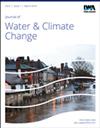A synergistic framework for dynamic water scarcity assessment: integrated blue and green water
IF 2.7
4区 环境科学与生态学
Q2 WATER RESOURCES
引用次数: 0
Abstract
Dynamic assessment of water scarcity utilising blue water (BW) and green water (GW) can enhance water resource management. The traditional water scarcity assessment mainly considers blue water, ignoring GW, for static evaluation. The improvement objective of this study is dynamically quantifying water scarcity, integrated BW and GW. This study proposed a framework to present an overview of water scarcity within multiple indicators and pinpoint water-stressed areas within an ever-changing process. The framework is based on the theorem of mutual change of quality and quantity to assess the spatiotemporal variability of BW and GW availability and to quantify the water scarcity in watersheds. A case study was carried out in Taoer River Basin, a semiarid region of China, to demonstrate the use of the framework. The anthropogenic elements (such as water demand) and natural conditions were combined to quantify water scarcity, as measured by BW and GW scarcity indices. This study also analysed the variation of water scarcity on different spatiotemporal scales. The findings demonstrate that severe water scarcity has been occurring downstream with a tendency towards upstream of the watershed. Collectively, this study provides a useful tool for dynamic water scarcity assessment, helping develop policies to promote sustainable development.动态缺水评估的协同框架:蓝色和绿色综合水体
利用蓝水(BW)和绿水(GW)对水资源短缺进行动态评估,可以加强水资源管理。传统的缺水评估主要考虑蓝水,忽略了绿水,进行静态评估。本研究的改进目标是综合蓝水和绿水,动态量化缺水程度。本研究提出了一个框架,在不断变化的过程中,通过多个指标展现水资源短缺的概况,并准确定位水资源紧张地区。该框架以水质和水量互变定理为基础,用于评估基本水量和一般水量可用性的时空变化,并量化流域缺水状况。在中国半干旱地区洮儿河流域开展了一项案例研究,以演示该框架的使用。将人为因素(如需水量)和自然条件结合起来,量化了缺水程度,并用 BW 和 GW 缺水指数进行了衡量。这项研究还分析了不同时空尺度上水资源短缺的变化情况。研究结果表明,严重缺水一直发生在下游,并有向流域上游发展的趋势。总之,这项研究为动态缺水评估提供了有用的工具,有助于制定促进可持续发展的政策。
本文章由计算机程序翻译,如有差异,请以英文原文为准。
求助全文
约1分钟内获得全文
求助全文
来源期刊

Journal of Water and Climate Change
WATER RESOURCES-
CiteScore
4.80
自引率
10.70%
发文量
168
审稿时长
>12 weeks
期刊介绍:
Journal of Water and Climate Change publishes refereed research and practitioner papers on all aspects of water science, technology, management and innovation in response to climate change, with emphasis on reduction of energy usage.
 求助内容:
求助内容: 应助结果提醒方式:
应助结果提醒方式:


